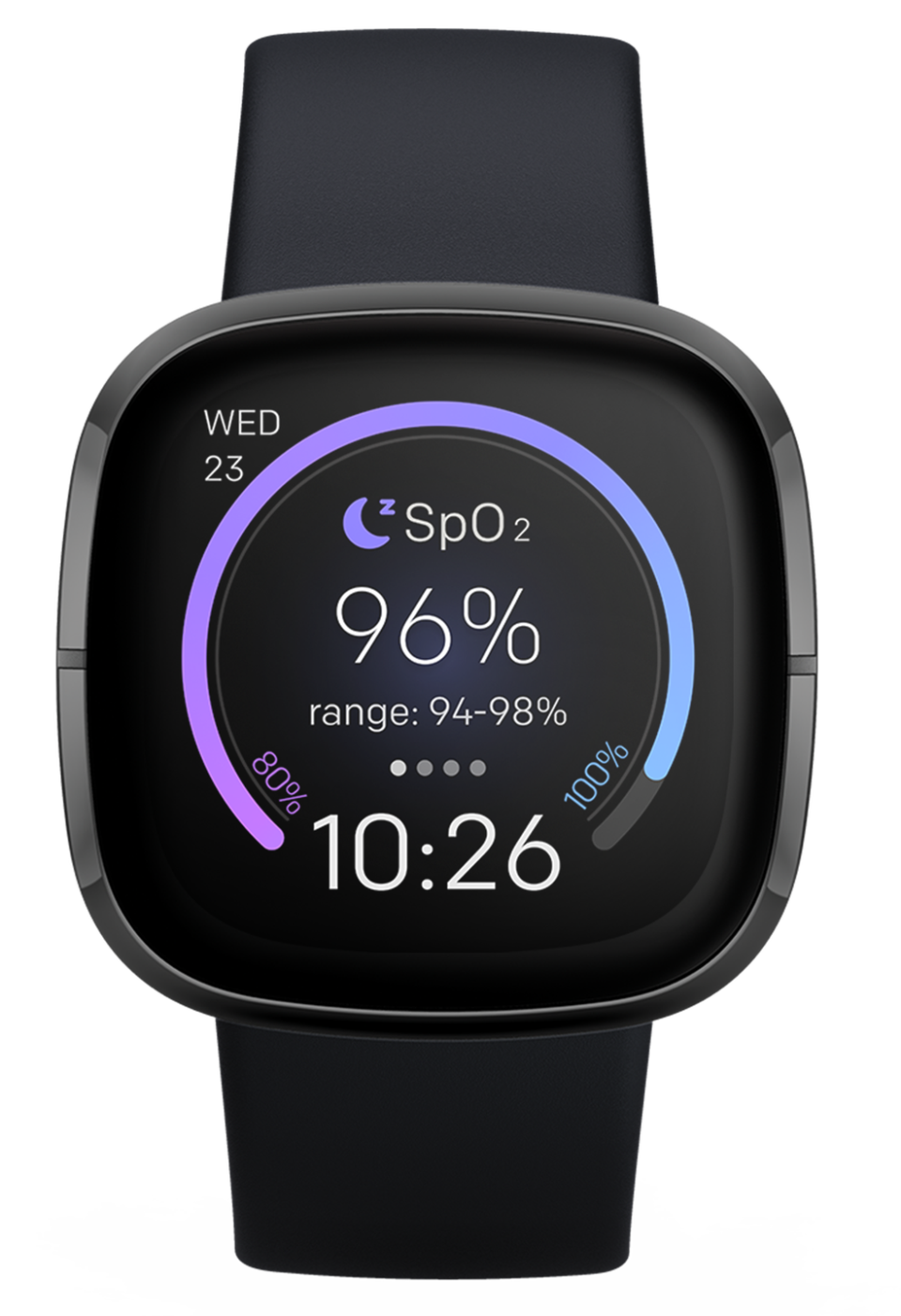The Fitbit Sense Can Do (Almost) Everything
Fitbit is ready to level up. The health and fitness tracking company has finally launched a follow-up to its top-level wearable, the Ionic (released in 2017), with the brand new Sense smartwatch.
Since the Ionic's debut, Fitbit made a few other smartwatches, establishing the Versa family as a solid (if basic) option for exercise and wellness buffs. But with the Ionic still sitting at the top of the product line without an update—its health and fitness-first focus, touting features like built-in GPS, was elevated above the more utilitarian Versa—something was missing. The Versa watches worked well, and had some features competitors couldn't match, like long battery life, sleep tracking, and (maybe most importantly), a low price point, but they couldn't measure up in other areas.
The Sense makes up for those issues and then some. (While I didn't test it, the next watch in the other line, the Versa 3, also looks like an improvement.) New sensors, processing smarts, and an improved heart rate monitor give the Sense just about every health feature you'll find in competitors, along with the aforementioned battery life and sleep tracking features Fitbit users already know and love. I tested the Sense and came away feeling more confident of its place on my wrist than any other Fitbit smartwatch since the Ionic.
The Sense's Sleeker Design
While Fitbit says that the Sense was created using "a new design language," you'd be hard-pressed to spot difference between it and the old Versa watches at a glance (the company also says the new Versa 3 was designed using the Sense's aesthetics). Instead of maintaining the Ionic's funky, edge-filled octagonal shape, Fitbit elected to copy the same rounded-corner square watch face of its last several releases. There are two notches on the sides of the Sense's face that aren't included in the Versa 3, if you actually take a moment to look, presumably a visual marker denoting the former's stainless steel and aluminum casing and the latter's aluminum.
While the similarity of the design might strike some as boring, I think it's a good call to err toward uniformity. The form factor plays into one of Fitbit's strengths: a deep product line. The Sense is compatible with all of the Versa 3's accessories, for one, and the resemblance to a certain other smartwatch line on the market—which also just happened to release two new devices in the exact same form factor—is only a benefit.
The Sense also sits better on the wrist than the Ionic ever did. What's more, the removal of all physical buttons in favor of one inductive control spot, a feature that first started showing up in Fitbit's Charge trackers, makes the watch more comfortable, especially in the gym or in bed. My typical wear test for wearables includes barbell front squats or pushups to see if the wrist extension of the movements mashes the buttons and exits the tracking function. The Sense passed the pushup test, only waking up the watch's screen during a rep or two. All that said, I do love the functionality of a physical button—the haptic feedback of the spot just doesn't do the same for me.
The button's removal is made possible by the smooth responsiveness of the smartwatch's OS, which is easy to navigate with swipes and taps. You can personalize the Sense more than any other Fitbit device I've tested, with customizable widgets to determine which data will be displayed onscreen and shortcuts to commonly used functions.
The Sense as a Stress Buster and Heart Hero
The sensors and health features are the Sense's real premium function.
Fitbit claims that the watch has the first ever electrodermal activity (EDA) sensor in a wearable, a function used to measure the body's response to stress. Using the feature is fairly straightforward: Initiate a reading, then place your palm over the watch for two minutes and relax. Once I stopped trying to sneak a peak at the timer, the reading was a nice opportunity to relax. The sensor detects responses ("tiny changes in sweat level") on your skin during the session and logs your starting and finishing heart rate. Then, you're prompted to record how you feel, part of Fitbit's focus on managing mood and stress using the device. Along with the EDA readings, you can perform guided breathing sessions on the watch, while "Mindfulness" and "Stress Management"—the latter of which uses biometric inputs to provide an individualized score not unlike Fitbit's Sleep tracking—are two prominent sections on the connected app.
The Sense also boasts a new ECG app to assess the wearer's heartbeat to detect abnormalities known commonly as atrial fibrillation, or AFib. A similar feature came to the Apple Watch Series 4 in 2018—and like Apple's functionality, Fitbit Sense's ECG won't be accessible at launch, as the capability was announced before Fitbit received FDA clearance for its use. The wait won't be long, however; Fitbit obtained the proper permissions for the ECG app shortly after the Sense was publicly unveiled, and the feature is expected to be available in October.

For now, though, you can use Fitbit's SpO2 watch faces to measure your blood oxygen level, another big Apple Watch feature announced this year. This function isn't unique to the Sense—I first tried it out using the Fitbit Versa 2—and it's simple to use. Just wear the device to bed, and the data collected while you sleep is used to calculate the percentage. Fitbit's app clearly states that the measure isn't meant for medical purposes (much like Apple's new messaging around its feature), but is only meant to provide information to help users gauge their wellness.
Finally, a new on-wrist temperature sensor tracks changes during sleep to monitor trends over time that could help to catch problems early. Like the SpO2 feature, this is totally passive and not meant to diagnose any conditions.
Much of the high-level data from these sensors is broken down at greater length in the helpful new Health Metrics Dashboard on the Fitbit app, which is only accessible for Fitbit Premium members (all Sense buyers will get a six-month trial of the service). I found the Dashboard extremely useful for parsing the data from all the sensors and actually understanding how it all fit together—so those who aren't willing to commit to extending the Premium service will be glad to know that Fitbit recently decided to roll out the Dashboard to the general user base for free in the coming months.
The Sense's Smarts
Along with all the new health features, the Sense still performs admirably as a fitness tracker. You'll feel comfortable using it if you've used any of the brand's watches before, and if you haven't, it won't take you long to figure it out. Step count goals are still an easy mark for low-intensity exercisers to get moving and engage with the device, while Fitbit's newer Activity Zones feature, introduced with the Charge 4, challenges more advanced wearers to hit a predetermined number of minutes in personalized heart rate zones for more vigorous effort. The Sense also added built-in GPS for enhanced fitness tracking, the first for a Fitbit smartwatch since the Ionic. The feature also makes it easier to leave your phone behind on an outdoor workout, if you feel so bold (on-device music storage via Pandora and Deezer make that even more appealing).

The Sense has solid smartwatch features, too, with phone notifications, NFC payments, and two smart assistants—Amazon Alexa is available at launch, and works fine for basic functions, while Google Assistant sill come later this winter.
One of my biggest pet peeves from Fitbit's other devices is finally, blessedly solved: the new charger uses a basic magnetic connection design instead of an awkward plastic housing. I've complained about the charger in every other Fitbit review, and I was probably a little more excited than I should've been when I unboxed the Sense and saw the new power setup. That charger is also powerful; Fitbit says a 12 minute charge will give the device a full day's worth of juice. My battery testing didn't match Fitbit's six-plus day estimate—I made it a little over five days—but I did a fair amount of tracking to test, and toggled the always-on display on and off, so that likely affected the duration.
The Bottom Line
The Sense is a more fully-realized smartwatch than anything Fitbit has released before, with health and fitness tracking features that can rival those of its biggest competitor in the space, Apple. That said, there are some shortcomings, namely the lack of quality apps and watch faces available.
The cost is a big leap for Fitbit, at $330, especially after the company launched the last Versa smartwatch at under $200 (the Versa 3 is $230). Buyers will have to look at the suite of sensors and services and determine if a Fitbit is worth Apple Watch money, a factor that hasn't been part of the equation in recent years. Since the Sense's price is more in line with premium competitors, it's also worth noting that iPhone connectivity with the Sense isn't quite as smooth as an Apple Watch—but that shouldn't be that big of a surprise, since Apple's whole proposition is a connected family of gadgets that work well together.
But Fitbit's Sense stands strong on its own merits, especially for Android users and fitness-focused users. The combination of design, health functionality, and smarts are at the top tier of the smartwatch market. If you want one of the best smart devices you can wear on your wrist, the Sense fits the bill.
You Might Also Like

